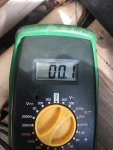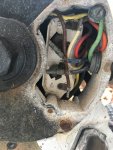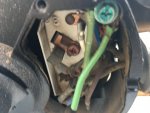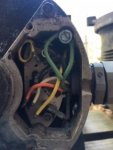I recently had GFCI breakers installed for my filter, waterfall, and booster pumps as the original were non-GFCI. I also replaced my old incandescent lights with 12v LED that are on a separate GFCI breaker. When the bonding wire is attached to either pump, the breaker trips immediately. The electrician double checked everything but can't find a cause so for now, I'm leaving pumps off when swimming. The breakers are Square D and the filter pump is about 6 yrs old. I understand the purpose of the bonding but since the only metals parts in the pool are the niches and now have the LEDs, do I still need it? Thoughts/suggestions? Thank you in advance!
Pump GFCI breaker trips when bonding wire attached
- Thread starter TomG
- Start date
You are using an out of date browser. It may not display this or other websites correctly.
You should upgrade or use an alternative browser.
You should upgrade or use an alternative browser.
Check for voltage between the bond wire and the bond lug.
Do you have pictures of everything?
Is there a ground wire on both pumps?
Do you have pictures of everything?
Is there a ground wire on both pumps?
Hi James, please see attached pics of the three pumps wiring connections. Grounds are connected on all. The Voltage meter reading was .1 when the pump
was running...it fluctuated back and forth from 0 to .1. Since the lug isn't attached currently, I tested it from the screw hole where the lug attaches to the bonding wire.
Same voltage when pump off but breaker still on. Seems like when testing my booster pump, I could detect a slight change in the "hum" the motor was making...don't know if that means anything. Thanks for your help and let me know if you need more pics.



was running...it fluctuated back and forth from 0 to .1. Since the lug isn't attached currently, I tested it from the screw hole where the lug attaches to the bonding wire.
Same voltage when pump off but breaker still on. Seems like when testing my booster pump, I could detect a slight change in the "hum" the motor was making...don't know if that means anything. Thanks for your help and let me know if you need more pics.




Attachments
Last edited:
All of the wiring looks old and corroded.
It might be a good idea to replace the wires.
The pumps might be leaking electricity, but the ground should do the same thing as the bond as far as tripping the gfci.
Maybe there's some current coming from the bond wire.
Maybe have a good electrician check it out.
It might be a good idea to replace the wires.
The pumps might be leaking electricity, but the ground should do the same thing as the bond as far as tripping the gfci.
Maybe there's some current coming from the bond wire.
Maybe have a good electrician check it out.
With the meter reading .1, start turning off power to each item, including 110v items in the area. Bingo when the meter drops to zero.
As previously stated, your ground wire should be tripping the GFCI unless the bonding wire is the source of voltage.
I just had an intelliflo drive leaking 110 volts, green wire and bonding wire were corroded, after cleaning wires, I had to junk the drive.
As previously stated, your ground wire should be tripping the GFCI unless the bonding wire is the source of voltage.
I just had an intelliflo drive leaking 110 volts, green wire and bonding wire were corroded, after cleaning wires, I had to junk the drive.
Wow, that 2nd picture shows the blue wire has backed out a lot from it's connection (notice the white and brown have the insulation inside the wire clamp / spade assembly.
But that black wire may only have a couple of strands still attached to the pump.
I'd redo at least about half of those connections first, hoping there is some slack in the conduit because it doesn't like the electrician was generous enough to leave you much to work with. I usually sandpaper down a new connection as I find some oxidation (tarnish) even under the insulation of the wire once you strip the end off to make a new connection.
Even the third picture shows some damage to the spade with the black wire nearly touching the blue.
Also looks like the blue and black were reversed between pumps. Sure there is still 240 V there, but why on earth wire the pumps differently.
Good luck!
But that black wire may only have a couple of strands still attached to the pump.
I'd redo at least about half of those connections first, hoping there is some slack in the conduit because it doesn't like the electrician was generous enough to leave you much to work with. I usually sandpaper down a new connection as I find some oxidation (tarnish) even under the insulation of the wire once you strip the end off to make a new connection.
Even the third picture shows some damage to the spade with the black wire nearly touching the blue.
Also looks like the blue and black were reversed between pumps. Sure there is still 240 V there, but why on earth wire the pumps differently.
Good luck!
One trick getting wire shiny and ready for a new crimp on of sort is to remove insulation and flatten out the strands like in a fan style formation. Then take a razor blade or sharp knife and scrape both sides of the fanned out wire to get fresh copper. When done twist it back and it's ready for new crimp with good contact.Wow, that 2nd picture shows the blue wire has backed out a lot from it's connection (notice the white and brown have the insulation inside the wire clamp / spade assembly.
But that black wire may only have a couple of strands still attached to the pump.
I'd redo at least about half of those connections first, hoping there is some slack in the conduit because it doesn't like the electrician was generous enough to leave you much to work with. I usually sandpaper down a new connection as I find some oxidation (tarnish) even under the insulation of the wire once you strip the end off to make a new connection.
Even the third picture shows some damage to the spade with the black wire nearly touching the blue.
Also looks like the blue and black were reversed between pumps. Sure there is still 240 V there, but why on earth wire the pumps differently.
Good luck!
borjis
LifeTime Supporter
Yes that wiring definitely doesn't look good in its current state. Cleaned contacts with freshly stripped wire and new connectors are in order. I would do all of them if that was how mine looked.
Just a guess but I think the problem is in your 2nd picture with the L2 connection and only a few strands.
When the 120v phase for L1 is "on" (like 1/60th of every second) the L2 connection may be seeing a load imbalance because it cannot return the same load to your electric service over those few still connected wires as your pump is using.
Which is just a fancy way of saying I think your wire connections need to be resecured and renewed.
Really the only hard part will be finding the correct spade plugs, those look like they are on a capacitor inside the pump, right?
I think you will only need new connectors, a utility knife, and a medium sized set of pliers to fix that.
Oh yeah scrape or use emery cloth on the capacitor terminals you will use to find bare metal.
When the 120v phase for L1 is "on" (like 1/60th of every second) the L2 connection may be seeing a load imbalance because it cannot return the same load to your electric service over those few still connected wires as your pump is using.
Which is just a fancy way of saying I think your wire connections need to be resecured and renewed.
Really the only hard part will be finding the correct spade plugs, those look like they are on a capacitor inside the pump, right?
I think you will only need new connectors, a utility knife, and a medium sized set of pliers to fix that.
Oh yeah scrape or use emery cloth on the capacitor terminals you will use to find bare metal.
Update...first, thanks everyone for the advice! I agree, the wiring connections needs some work! I bought a new analog meter as my digital meter has been
somewhat flaky in it's reading over past several years and it actually was showing a ready when not touching anything! But with the new meter, I'm not getting any needle movement and I verified it can measure AC voltage via an outlet. I also checked for GFCI tripping again. When running, if I touch the bonding wire to the pump lug, the breaker trips. I tested separately for the filter pump and the waterfall pump which btw is the "barely connected" L2 wire mentioned by Poolfool. The waterfall pump is an old (original) Jandy Stealth pump from 2004. The filter pump is a Jandy Flo Pro that was installed in 2014 when we bought the house. So would the next best course of action be... 1) Fix the bad connections; 2) If still an issue, re-wire the pumps entirely to the breakers?
somewhat flaky in it's reading over past several years and it actually was showing a ready when not touching anything! But with the new meter, I'm not getting any needle movement and I verified it can measure AC voltage via an outlet. I also checked for GFCI tripping again. When running, if I touch the bonding wire to the pump lug, the breaker trips. I tested separately for the filter pump and the waterfall pump which btw is the "barely connected" L2 wire mentioned by Poolfool. The waterfall pump is an old (original) Jandy Stealth pump from 2004. The filter pump is a Jandy Flo Pro that was installed in 2014 when we bought the house. So would the next best course of action be... 1) Fix the bad connections; 2) If still an issue, re-wire the pumps entirely to the breakers?
I will agree and second the advice to fix the wiring although I doubt it is the reason the GFCI is tripping. The GFCI is only looking at the power the pump is using and monitoring it on the return side, so what ever is going into the pump via the 2 or 3 strands is all it is looking for on the return. I would be more concerned that the connection might over heat with the bad connections.
The GFCI is tripping because it is sensing that the current flow is returning somewhere other than the neutral wire. I would suspect that the old wiring may be shorting to the case of the pump ever so slightly that it won't cause the breaker to trip but is allowing enough current to be straying that it is causing the GFCI to trip.
My suspicion is the grounding circuit for the pump/motor is compromised somewhere. If this is the case, current can be on the motor housing and as long as it can't go anywhere it won't trip the GFCI or the breaker. Once the bonding wire is connected, it is allowing the current to flow somewhere telling the GFCI that there is a current leak.
To check this, Measure the voltage from the L1 wire to the ground screw inside the connection area. You should read the same voltage that you would see if you measured between the L1 and L2 (assuming this is 120 volt and not 240). If this is the case, you will need to find out where the current leak in the motor is.
Dan
The GFCI is tripping because it is sensing that the current flow is returning somewhere other than the neutral wire. I would suspect that the old wiring may be shorting to the case of the pump ever so slightly that it won't cause the breaker to trip but is allowing enough current to be straying that it is causing the GFCI to trip.
My suspicion is the grounding circuit for the pump/motor is compromised somewhere. If this is the case, current can be on the motor housing and as long as it can't go anywhere it won't trip the GFCI or the breaker. Once the bonding wire is connected, it is allowing the current to flow somewhere telling the GFCI that there is a current leak.
To check this, Measure the voltage from the L1 wire to the ground screw inside the connection area. You should read the same voltage that you would see if you measured between the L1 and L2 (assuming this is 120 volt and not 240). If this is the case, you will need to find out where the current leak in the motor is.
Dan
Just measure voltage between the bonding wire and the point that it mounts. Agree ground wire must be open, disconnected, or corroded.
You can narrow it down maybe by removing everything on the bond wire and first connect only your newest motor, then your older waterfall pump motor, etc etc. It does not take much to trip a GFCI , even a dead fried spider or ant will do it. Dust / dirt that is damp can also be an issue between your hot legs and the motor casing in your case because if it was to ground it would pop the GFCI even without the bond connected.
tstex
Silver Supporter
If you have the time, I would completely replace all the wiring and re-homerun it from pump to breaker, then give yourself a little extra on one end or the other? the only exception is if you have extra wiring in the panel that you can pull down onto the pump, and when you strip off the insulation, all of the conductors are bright copper and have great integrity. If not, redo them bc you are eventually going to replace the pump and having good conductors is a must
Next, determine if the motor housing cover still has a good seal or not? no use in inviting oxidation into the housing if you can prevent it.
Finally, with a 16 yr old pump, your motor parts might be compromised. If you can, take it to a good motor/electronics shop and let them test it for you...or, spend the money on a new pump since it's going in 17 yrs old...
Next, determine if the motor housing cover still has a good seal or not? no use in inviting oxidation into the housing if you can prevent it.
Finally, with a 16 yr old pump, your motor parts might be compromised. If you can, take it to a good motor/electronics shop and let them test it for you...or, spend the money on a new pump since it's going in 17 yrs old...
Thread Status
Hello , This thread has been inactive for over 60 days. New postings here are unlikely to be seen or responded to by other members. For better visibility, consider Starting A New Thread.


